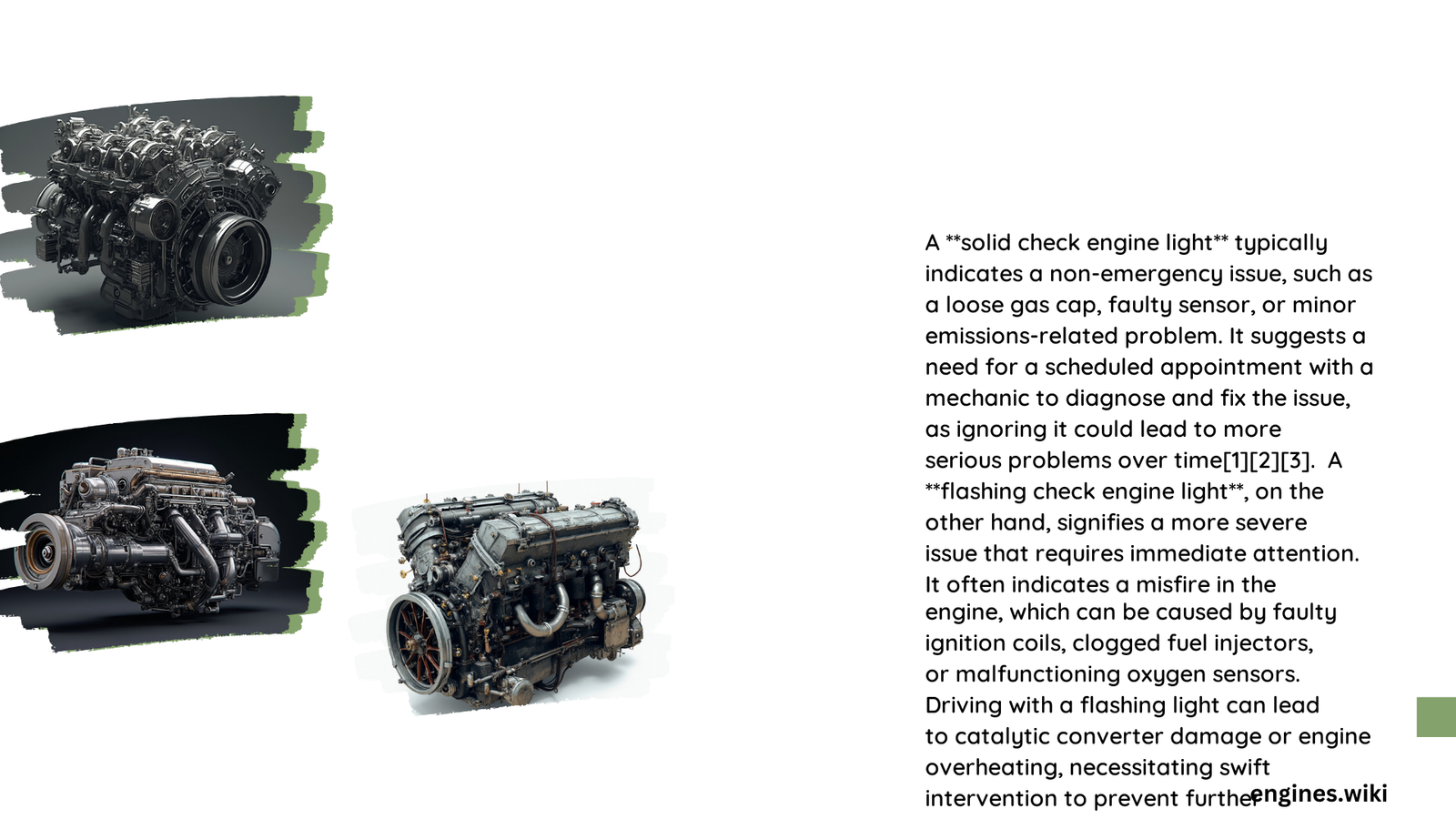The check engine light is a crucial indicator in your vehicle’s dashboard that can signal various issues. Understanding the difference between a flashing and solid check engine light is essential for proper vehicle maintenance and safety. A solid light typically indicates less urgent problems, while a flashing light signifies severe issues requiring immediate attention. This article delves into the specific causes, meanings, and recommended actions for both scenarios to help you maintain your vehicle’s health and avoid costly repairs.
What Does a Solid Check Engine Light Mean?
A solid check engine light typically indicates less urgent issues that still need attention. Common causes include:
- A loose gas cap
- Minor engine sensor problems
- Faulty oxygen sensors
- Other non-critical system malfunctions
While these issues are not immediate emergencies, they should be addressed to prevent escalation. The solid light means that the vehicle’s onboard computer has detected a fault code that requires investigation but is not critical to engine operation.
How Urgent is a Solid Check Engine Light?
A solid check engine light has a lower urgency level compared to a flashing light. However, it’s still important to address the issue promptly. Here’s what you need to know:
- Timing: Schedule a visit to a mechanic within a few days to a week.
- Potential Risks: Ignoring a solid check engine light can lead to:
- Increased emissions
- Potential engine damage over time
- Higher repair costs if left unaddressed
What Should You Do When You See a Solid Check Engine Light?
- Check your gas cap to ensure it’s properly tightened.
- Monitor your vehicle’s performance for any noticeable changes.
- Schedule an appointment with a mechanic for a diagnostic check.
- Use an OBD-II scanner if you have one to read the fault codes.
What Does a Flashing Check Engine Light Indicate?

A flashing check engine light signifies more severe and urgent problems, often related to engine performance. Common causes include:
- Engine misfires, where one or more cylinders are not firing correctly
- Faulty spark plugs or ignition system defects
- Catalytic converter problems due to unburned fuel entering the exhaust system
- Serious engine mechanical issues, such as fuel system problems or internal engine issues
These issues require immediate attention to prevent significant engine damage.
How Serious is a Flashing Check Engine Light?
A flashing check engine light is a high-urgency situation that demands immediate action. Here’s why it’s so critical:
- Meaning: Signifies a severe issue that could cause immediate damage to the engine.
- Potential Risks:
- Significant engine damage
- Overheating
- Catalytic converter failure
- Risk of fire
- Costly repairs
- Vehicle breakdown
What Actions Should You Take When the Check Engine Light is Flashing?
- Pull over to a safe location immediately.
- Turn off the engine to prevent further damage.
- Call for professional assistance or a tow truck.
- Do not attempt to drive the vehicle to a mechanic.
- Have the vehicle diagnosed and repaired as soon as possible.
How Do Mechanics Diagnose Check Engine Light Issues?
Mechanics use various tools and techniques to diagnose both solid and flashing check engine lights:
- OBD-II Scanner: This is the primary diagnostic tool used to read fault codes.
- Visual Inspection: Mechanics perform a thorough visual check of engine components.
- Advanced Diagnostic Tools: For complex issues, specialized tools may be used.
What are the Average Costs for Check Engine Light Diagnostics and Repairs?
| Service | Cost Range |
|---|---|
| Diagnostic Fee | $50 – $150 |
| Solid Light Repairs | $20 – $500 |
| Flashing Light Repairs | $500 – $2,000+ |
Costs can vary significantly depending on the specific issue and the make and model of your vehicle.
What are the Long-Term Consequences of Ignoring Check Engine Lights?
Solid Check Engine Light:
- Increased fuel consumption
- Higher emissions
- Gradual performance decline
- Potential for more serious issues to develop
Flashing Check Engine Light:
- Severe engine damage
- Complete engine failure
- Extremely costly repairs or engine replacement
- Safety risks, including potential vehicle fires
How Can You Prevent Check Engine Light Issues?
- Follow your vehicle’s recommended maintenance schedule.
- Address minor issues promptly before they escalate.
- Use high-quality fuel and parts.
- Have regular check-ups with a trusted mechanic.
- Pay attention to any changes in your vehicle’s performance.
By understanding the difference between a flashing and solid check engine light, you can take appropriate action to maintain your vehicle’s health and avoid costly repairs. Remember, a solid light requires attention soon, while a flashing light demands immediate action. Always prioritize your safety and the longevity of your vehicle when dealing with check engine light issues.
References:
1. Nerger’s Auto Express
2. Shawnee Station Automotive
3. The Garage Automotive Solutions
